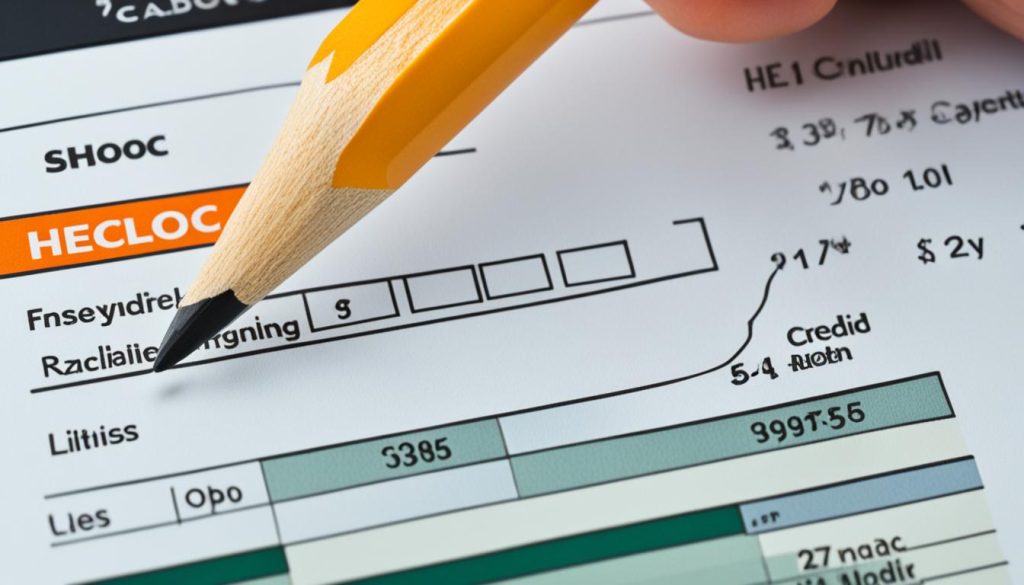Are you a homeowner looking for flexible financing options? If so, understanding a home equity line of credit (HELOC) can provide you with the financial flexibility you need. While Rocket Loans does not offer a HELOC specifically, it’s important to know how it works and explore other home equity options.
A HELOC is a type of second mortgage that allows you to borrow against the equity in your home. With Rocket Loans’ expertise in home equity financing, you can explore other alternatives that suit your needs. Qualifying for a HELOC typically requires good credit, a qualifying amount of equity in your home, responsible payment history, a low debt-to-income ratio, and reliable income.
Understanding the repayment phases of a HELOC is also crucial. The draw period allows you to borrow from your line of credit, with minimum or interest-only payments required. Once the draw period ends, the repayment period begins, where full monthly payments covering the principal and interest become mandatory.
Key Takeaways:
- A home equity line of credit (HELOC) can provide flexible financing options for homeowners.
- Rocket Loans does not offer a HELOC specifically, but other alternatives are available.
- Qualifying for a HELOC requires good credit, sufficient home equity, responsible payment history, a low debt-to-income ratio, and reliable income.
- HELOC repayment consists of a draw period and a repayment period.
- Exploring other home equity options, such as a cash-out refinance or a home equity loan, may be beneficial.
Qualification Requirements and Repayment Phases
Qualifying for a Home Equity Line of Credit (HELOC) requires meeting specific eligibility criteria. To secure a HELOC, applicants typically need to meet the following qualification requirements:
- Good credit: A credit score in the mid-600s to above 700 is usually necessary for HELOC approval.
- Equity in the home: Lenders typically require a qualifying amount of equity in the home, ranging from 15% to 20%.
- Responsible payment history: Demonstrating a history of on-time payments is crucial in the HELOC application process.
- Low debt-to-income ratio: Lenders evaluate an applicant’s debt-to-income ratio to ensure they can comfortably manage the additional debt.
- Reliable income: Sufficient and stable income is essential to prove the ability to make timely HELOC payments.
A HELOC repayment consists of two distinct phases: the draw period and the repayment period.
The draw period is the initial stage of a HELOC, during which borrowers can access funds from their line of credit. Borrowers have the flexibility to borrow as needed and make minimum or interest-only payments during this period. If the credit limit is reached, borrowers must repay part of the balance before accessing additional funds.
The repayment period begins after the draw period ends. During this phase, borrowers are required to make full monthly payments, which cover both the principal and the interest of the HELOC. The length of the draw and repayment periods varies depending on the chosen loan terms. For example, a HELOC with a 30-year term may have a 10-year draw period and a subsequent 20-year repayment period.
Understanding the qualification requirements and the repayment phases of a HELOC can help borrowers make informed decisions when applying for this type of financing.
| Qualification Requirements | Repayment Phases |
|---|---|
|
|
Pros and Cons of a HELOC
A Home Equity Line of Credit (HELOC) offers several advantages and disadvantages that homeowners should consider when exploring their financing options. It’s important to weigh the pros and cons before deciding if a HELOC is the right choice for your financial needs.
Pros of a HELOC
- Consolidate Debt: One of the main benefits of a HELOC is the ability to consolidate high-interest debt, such as credit cards or personal loans, into a single loan with a lower interest rate. This can save you money on interest payments and simplify your monthly finances.
- Flexible Use of Funds: With a HELOC, you have the flexibility to use the funds for various expenses, such as home improvements, education costs, or unexpected medical bills. The money is available to you as a revolving line of credit, allowing you to access it whenever you need it.
- Continued Borrowing: A HELOC allows you to continue borrowing against the available credit even after you have paid off a portion of the balance. This ongoing access to funds can provide you with financial peace of mind and the ability to tackle future expenses.
- Tax Deductible Interest: If you use the funds from a HELOC for home improvements, the interest you pay may be tax-deductible. This can potentially lower your overall tax liability and provide additional financial benefits.
Cons of a HELOC
- Upfront Costs: While a HELOC offers flexibility, it also comes with upfront costs, such as annual fees or origination fees. These costs can be significant, making a HELOC less worthwhile if you plan to borrow a small amount.
- Risk of Losing Your Home: With a HELOC, your home serves as collateral for the loan. If you are unable to make payments, there is a risk of losing your home through foreclosure. It’s important to carefully assess your ability to meet the repayment obligations before committing to a HELOC.
- Rate and Payment Increases: HELOCs typically have variable interest rates that can change over time based on market fluctuations. This means that your monthly payments may increase, potentially putting a strain on your budget. It’s important to consider the potential for rate and payment increases when evaluating a HELOC.
If you decide to pursue a HELOC, it’s recommended to use it for financially beneficial purposes, such as increasing the value of your home or paying for higher education. It’s important to carefully review the terms and conditions of the loan, compare lenders to get the best rate, and ensure that you have a solid plan for repayment to make the most of a HELOC.

Calculating HELOC Credit and Interest Rates
When considering a home equity line of credit (HELOC), it’s important to understand how to calculate your HELOC credit limit and the interest rates associated with this type of financing.
Calculating HELOC Credit Limit
Knowing your HELOC credit limit can help you determine how much you can borrow against the equity in your home. To calculate your HELOC credit limit, you can use the following formula:
HELOC Credit Limit = (Home Value x Lender’s Loan-to-Value Percentage) – Current Mortgage Balance
For example, let’s say your home has a value of $300,000 and your lender’s loan-to-value percentage for a HELOC is 80%. If your current mortgage balance is $200,000, the calculation would be as follows:
HELOC Credit Limit = ($300,000 x 80%) – $200,000 = $80,000
Based on this calculation, your HELOC credit limit would be $80,000.
Understanding HELOC Interest Rates
Interest rates on a HELOC are an important factor to consider when weighing the costs and benefits of this type of financing. Here are a few key points to keep in mind:
- HELOC interest rates are typically slightly higher than mortgage loan rates but lower than personal loan or credit card rates. This makes a HELOC an attractive option for borrowers seeking lower interest rates.
- Most HELOCs have variable interest rates, which means they can change over time based on market fluctuations. This can lead to fluctuations in your monthly payments.
- Fixed-rate HELOCs are also available, offering borrowers the stability of a fixed interest rate throughout the life of the loan. This can be beneficial for budgeting purposes.
- To ensure you get the best rate for a HELOC, it’s recommended to shop around and compare lenders. Different lenders may offer varying interest rates and terms, so taking the time to research and compare can help you secure the most favorable rate.
- Improving your credit score may also help you qualify for better interest rates on a HELOC. Lenders often offer lower rates to borrowers with strong credit histories.
By understanding how to calculate your HELOC credit limit and the factors that affect interest rates, you can make informed decisions when considering a home equity line of credit.
HELOC Interest Rates Comparison
| Lender | Interest Rate |
|---|---|
| Lender A | 4.25% |
| Lender B | 4.50% |
| Lender C | 4.75% |
| Lender D | 5.00% |

Use the table above to compare the interest rates offered by different lenders for a HELOC. Remember, the best rate for a HELOC can differ based on your specific financial situation and creditworthiness.
Calculating your HELOC credit limit and understanding the interest rates associated with a HELOC are essential steps in the decision-making process when considering this type of financing. By doing your research, comparing options, and assessing your financial situation, you can make informed choices that align with your financial goals.
Conclusion
While Rocket Loans may not offer a home equity line of credit (HELOC), it’s crucial to have a clear understanding of the concept and explore other flexible financing options for your home. A HELOC enables homeowners to tap into their equity, but it’s essential to meet certain criteria, including having good credit, a qualifying amount of equity, responsible payment history, a low debt-to-income ratio, and stable income.
Before considering a HELOC, carefully evaluate the advantages and disadvantages. The repayment process involves a draw period and a repayment period, so it’s important to be aware of the commitment involved. To make informed decisions, calculate your HELOC credit limit and familiarize yourself with the associated interest rates.
If a HELOC doesn’t align with your requirements, explore alternative solutions like a cash-out refinance or a home equity loan. Understanding the flexible financing options available, including HELOCs, can help you leverage the value of your home for various financial needs.
